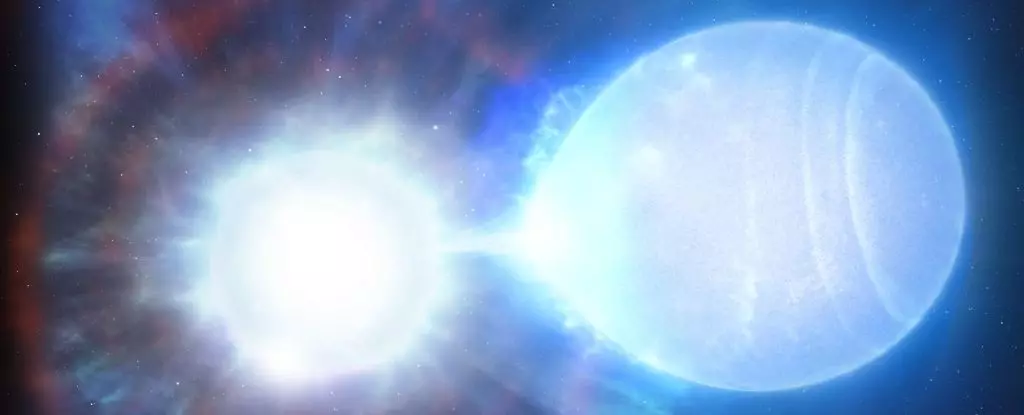In the grand tapestry of the universe, the lifecycle of stars is a fundamental narrative, a cosmic tale that encompasses birth, evolution, and death. Every celestial body, from the brightest suns to the dimmest dwarf stars, ultimately succumbs to fate, their incandescent brilliance extinguished in profound silence. Recent astronomical investigations have unveiled not only the impending demise of these stellar giants but have also offered unprecedented insights into the mechanics of supernovae, specifically the Type Ia variety. These stellar explosions serve as cosmic signposts, delineating distances across vast interstellar spaces.
From a binary star system located approximately 150 light-years from our planet, scientists have unearthed groundbreaking evidence that may redefine our understanding of Type Ia supernovae. Instead of the singular white dwarf previously thought to play a starring role in these explosive phenomena, it is now believed that two white dwarfs entangled in a binary orbit are primarily responsible for these dramatic celestial events. This shift in perspective not only affirms longstanding theories but also enriches our cosmic narrative.
The Mechanics of White Dwarfs
White dwarfs, in their essence, are remnants of stars that have exhausted their nuclear fuel, transitioning from luminous giants into dense stellar remnants. As stars like our Sun exhaust their hydrogen reserves, they cannot sustain the required thermal pressure, leading to collapse under their gravity. The white dwarf, a result of this process, represents a stage in stellar evolution where the core contracts into a dense entity roughly the size of Earth but containing the mass of up to 1.4 solar masses—a limit known as the Chandrasekhar limit.
The intrigue surrounding Type Ia supernovae stems from their explosive nature, their brightness serving as a reliable metric for astrological distance measurements. This peculiarity is crucial; it allows astronomers to employ these stellar explosions as benchmarks to gauge the universe’s expansion and to understand its anatomy more effectively. Hence, the discovery of binaries containing white dwarfs is not merely an astronomical find, but a pronounced leap in our capability to measure cosmic realities.
The Groundbreaking Discovery
Astrophysicists, including James Munday from Warwick University, have identified a unique binary system named WDJ181058.67+311940.94, an astonishing celestial pair with a mass exceeding that of our Sun and a remarkably close orbit. With these two white dwarfs anticipated to spiral toward each other over billions of years before inevitably merging in a cataclysmic Type Ia supernova, the implications of their inevitable collision offer fertile ground for speculation about future cosmic events.
This discovery is not merely significant because of its potential outcomes, but also because it reshapes the scientific narrative surrounding supernovae origins. Until now, the precise progenitors of these stellar explosions were cloaked in ambiguity. By confirming the binary origin hypothesis, Munday and his team have illuminated a path for future explorations, helping astronomers not only to trace the origins of Type Ia supernovae but also to anticipate their explosive potential.
A Window into the Ultimate Cosmic Future
As we grapple with the implications of this discovery, one must acknowledge the broader narrative at play. The universe, in its unfathomable vastness and complexity, continually reminds us of our own insignificance and temporal fragility. While WDJ181058.67+311940.94’s impending supernova lies an astronomical 23 billion years in the future, it opens questions about our place within the cosmic canvas. By the time this binary duo finally detonates, our Earth and potentially our species may have long departed from existence, leaving this significant stellar event to be observed only by distant life forms—or perhaps nothing at all.
Moreover, with an understanding that there exist numerous similar binary systems within our Milky Way, one cannot help but ponder the untapped mysteries hidden beyond the horizon. Each discovery nudges humanity towards a more profound appreciation of celestial mechanics, reinforcing the intricate connections between stars, galaxies, and the remains of worlds lost to time.
The Future of Stellar Research
The research associated with these binary white dwarfs serves as a testament to our evolving grasp of cosmic phenomena. With this solid grounding in observational evidence, it becomes increasingly conceivable to refine our models of the universe, leading to unprecedented inquiries about the origins of elements, the nature of dark energy, and the dynamics of cosmic expansion.
As astronomers gear up to explore further into our galactic neighborhood, the implications of identifying more systems akin to WDJ181058.67+311940.94 could potentially refine the methodologies we utilize for understanding supernovae, bridging gaps in our knowledge and urging us onward in the eternal quest for cosmic truth. Through a blend of observation, theory, and imagination, we stand on the precipice of extraordinary discoveries that may unveil the very fabric of our universe.

